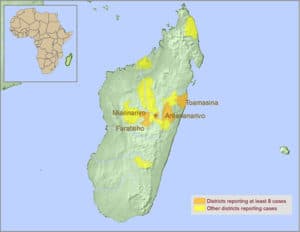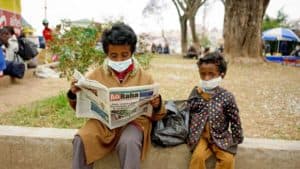This might be news to some, but centuries after the black death took 25 million lives – an estimated 60% of the European population – the plague is still present in our modern world. Madagascar, an island located off the southeast coast of Africa and home to 24.89 million residents, is experiencing an unprecedented endemic of the disease, with 57 fatalities and more than 684 cases … and counting.

The country suffers an estimated 400 cases of the plague per year, but this outbreak is markedly more unsettling as health officials note that the infections are occurring 3 months earlier than normal (since August) and expanding into urban areas. Usually, Madagascar experiences the bubonic plague in the rural highlands, but the current outbreak is spreading into more densely populated areas for the first time, including the country’s busy capital of Antananarivo. According to the World Health Organization (WHO), “due to the increased risk of further spread and the severe nature of the disease, the overall risk at the national level is considered very high.” In response to the reported cases sweeping into the capital, schools have been closed and public gatherings have been prohibited.
Just like the world history books from grammar school told us, the bubonic plague is spread by bites from infected fleas (it is transmitted from animals, usually rats to fleas) and is caused by an infection with the bacterium Yersinia pestis. But unlike the almost certain death of the medieval plague, modern antibiotics are available and effective in treating the disease. Symptoms include fever, abdominal pain, nausea, vomiting and often – swollen lymph nodes (lending the name ‘bubonic’ from the telltale buboes). If left untreated, the plague can spread to the lungs and cause pneumonia, and sometimes lead to death.
The current outbreak is of unique concern as 70% of the reported cases are of the pneumonic plague – which is more damaging and can be transmitted from human to human via coughing or sneezing. Like the bubonic form, pneumonic is also curable with common antibiotics. However, early detection is of absolute necessity, as an infected person may die within 12-24 hours of transmission.
Seychelles
The outbreak is not contained to Madagascar either. A 34-year-old man from Seychelles (a group of islands also in the Indian Ocean, home to 93,000 people) is reported to have the pneumonic plague upon returning from a recent trip to Madagascar, bringing the disease to the small country for the first time. Dr. Jude Geodon, Seychelles public health commissioner, announced a plague isolation ward and prohibits foreign travelers who have recently visited Madagascar to enter their country.
International Response

The health response is coordinated by the Ministry of Public Health and co-lead by WHO and related agencies. According to the October 6 press release from the WHO, the organization delivered 1.2 million doses of antibiotics and released $1.5 million immediate emergency funds for immediate support, and sent plague specialists and epidemiologists to the island. WHO and local officials are training healthcare workers on how to identify and care for infected individuals and “how to trace people who have had close contact with symptomatic patients so that they may be given protective treatment.”
The International Federation of Red Cross is deploying a full medical team and its first plague-treatment center; a 50-bed treatment facility and donated $250,000 for relief efforts. UNICEF donated another $500,000 and USAID donated 18,000 respirator masks, 100,000 masks, and 10 vehicles.
Most global health organizations agree that the risk for an international spread is fairly low as “generally, people with the plague are too sick to travel,” notes Daniel Bausch, director of the UK Public Health Rapid Support team. However, Madagascar will likely see a spike in cases before this is all over as “surveillance has improved and therefore health authorities will receive of more cases from more areas,” said Bausch.
How Can Travelers Protect Themselves
There is no vaccine available for the plague, and VIGILINT advises anyone who thinks they may have had close contact with individuals with the plague (or close contact with individuals who have visited Madagascar in recent months) to see their healthcare provider immediately. The CDC has initiated a Level 2 warning to travelers visiting Madagascar, “Practice Enhanced Precaution” and advise carrying insect repellent to prevent flea bites.
